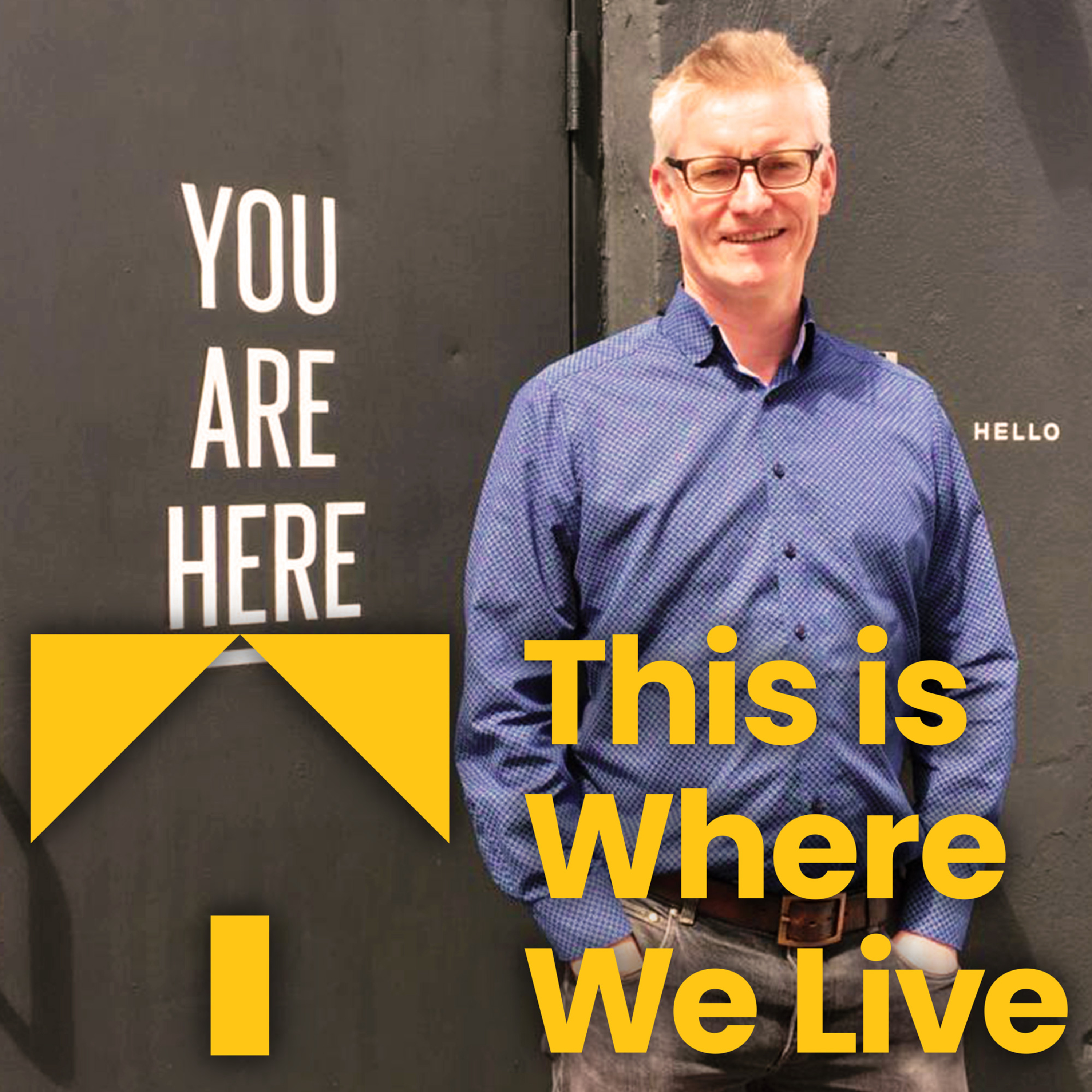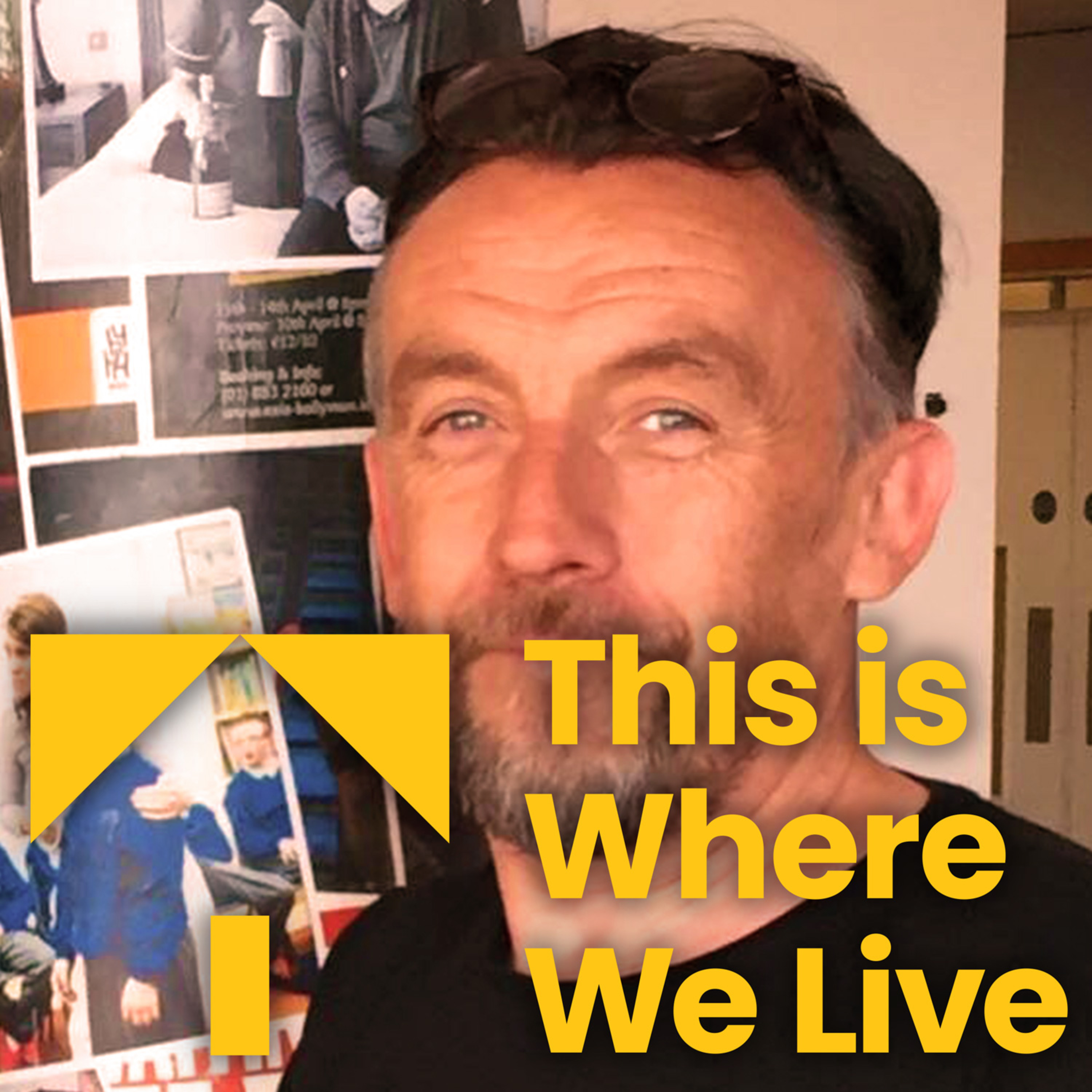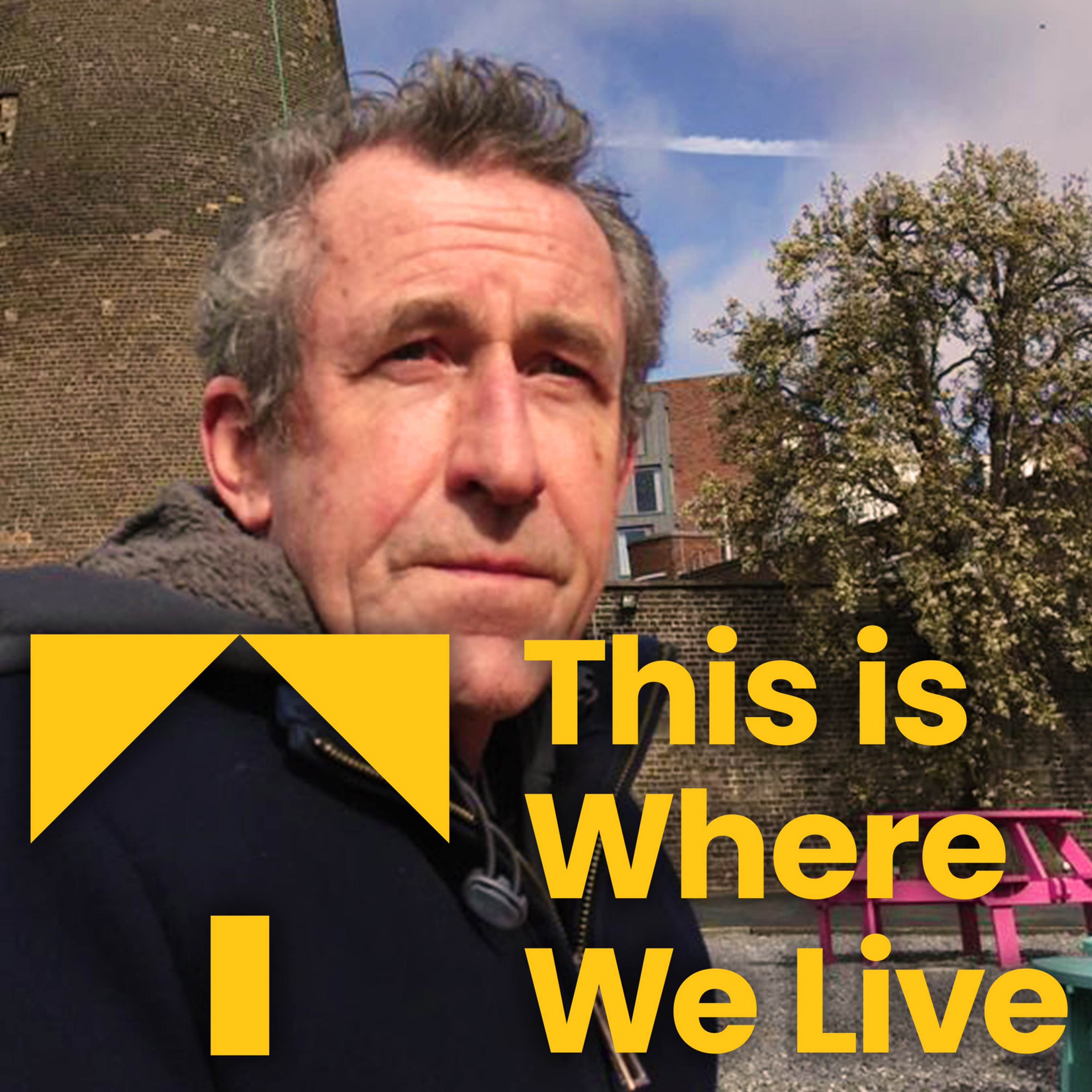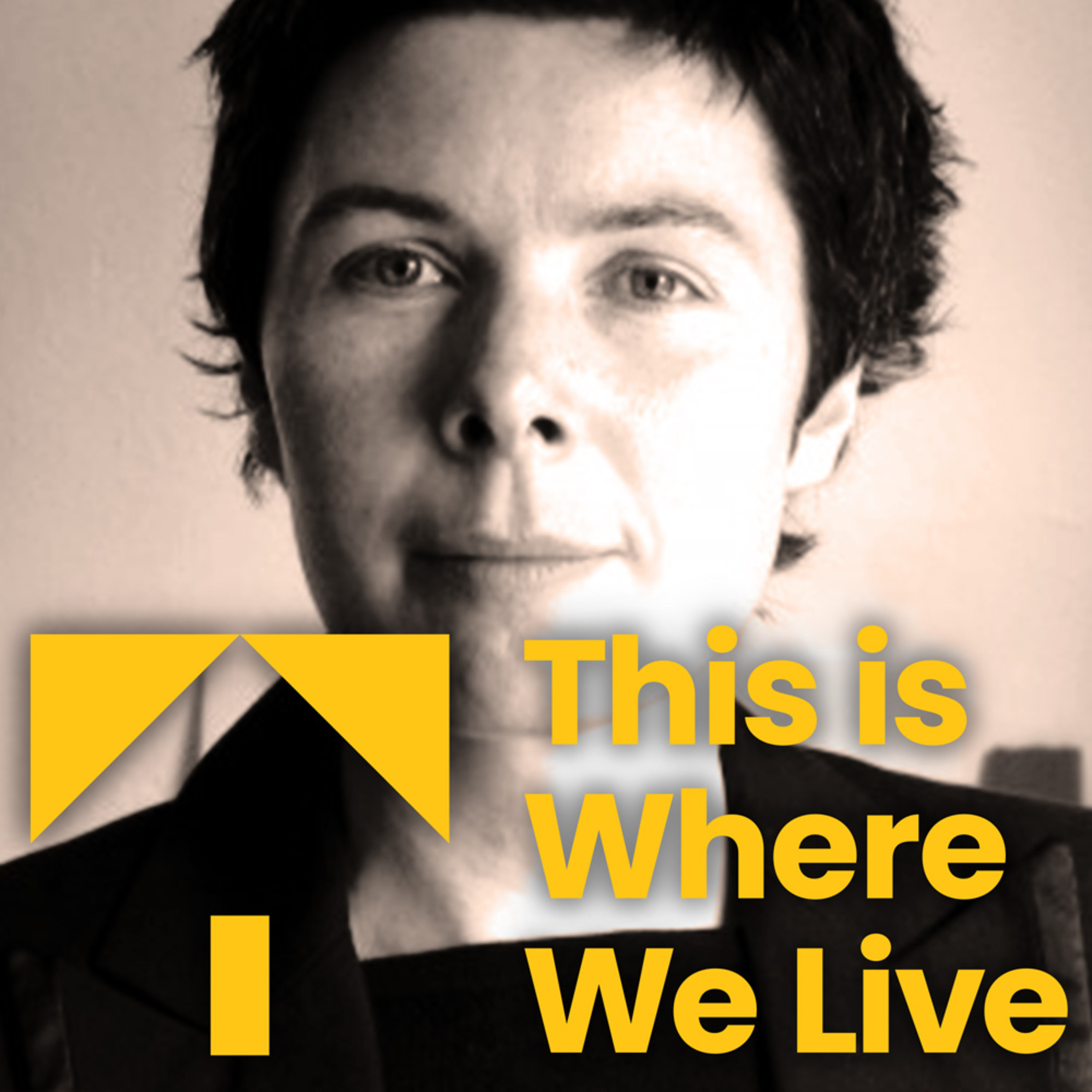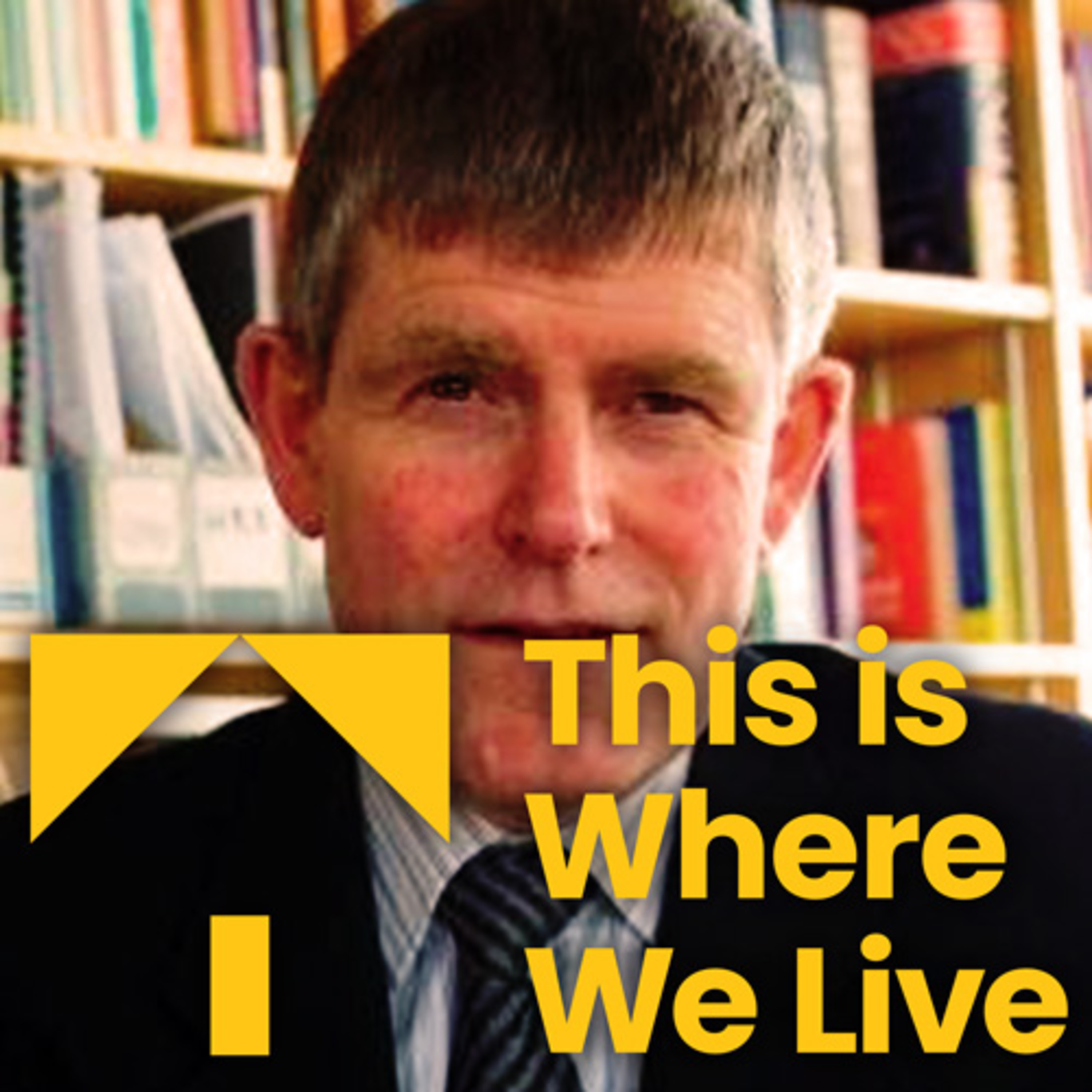Discover This is Where We Live
This is Where We Live

This is Where We Live
Author: This is Where We Live
Subscribed: 7Played: 48Subscribe
Share
© This is Where We Live
Description
This is Where We Live is an audio podcast and transmedia series exploring what it takes to shape great places to live and how Ireland is facing up to its future.
A story of housing and homelessness, of living and waiting, and of challenges and solutions.
This is Where We Live is an independent production made by Helen Shaw & John Howard of Athena Media Ltd.
A story of housing and homelessness, of living and waiting, and of challenges and solutions.
This is Where We Live is an independent production made by Helen Shaw & John Howard of Athena Media Ltd.
26 Episodes
Reverse
This Is Where We Live: Brendan Kenny, Deputy Chief Executive, Dublin City Council, with responsibility for housing and community services.
In this podcast in the This Is Where We Live series Brendan Kenny, who is in charge of Dublin City Council's housing policy and strategy gives his take on why housing has become such a challenge for the city and how, in his view, a regional integrated plan is needed, across Dublin City and County and the surrounding counties.
Find out more about DCC Housing here www.dublincity.ie/housing-and-community
and visit our website for more resources podcasts www.thisiswherewelive.ie
To tie in with the exhibition on show across July 2019 in Dublin City Council at Wood Quay we hosted a live radio discussion around the topics in Dublin City fm with Dr Mary Murphy, Senior Lecturer, Social Sciences Institute (MUSSI), Dr Rory O'Donnell, Director, NESC, Oona Kenny, Researcher, Dublin Housing Observatory, Dr Dáithí Downey, Head of Housing Policy, Research & Development, Dublin City Council.
You can find out more on www.housingmodeldublin.ie and to listen to the series go to www.thisiswherewelive.ie
In the photo : Rory O'Donnell, Oona Kenny, Dáithí Downey and Mary Murphy.
The exhibition The Vienna Model is on display in the atrium of Dublin City Council at Wood Quay www.housingmodeldublin.ie
In this the last episode in our 4 part series The Vienna Model: Housing for the 21st Century we're bringing out the stories and conversations of those most affected by housing and homelessness, in particular community voices from St Michael's Estate in Dublin. St Michael's Estate has had a long, protracted and painful experience of regeneration with over a decade lost due to the recession.
In this series we're showcasing the seminars that took place in April 2019 as part of a discussion around solutions for the housing crisis in Ireland, particularly in Dublin. In this podcast you hear Eilish Comerford, a community worker from St Michael's Family Resource Centre in St Michael's Estate who is also part of a grassroots activism network around housing. Eilish talks of the need for new funding sources to ensure the affordability of these new cost rental homes planned for St Michael's Estate and we hear from the European Investment Bank on its role as a potential funding source to secure affordability housing.
Cormac Murphy is the Head of the EIB here and he described the new Land Development Agency, the LDA as a game changer in providing affordable housing. Ireland, he says, has a profile with just 10% social housing and that's out of step with other European cities and this change in models and funding is critical to making an attractive, sustainable city that works for all. nterestingly we also hear from David Joyce, a solicitor who works with Mercy Law Resource Centre, who works in the field of housing and homelessness, and is himself from the traveller community, who responded to the discussion by drawing on the comments that Michaela Kauer from Vienna made earlier ( and in Podcast 1) that in Vienna housing is for all, and is invested in heavily because it is seen as a human right that underscores society. 'We stigmatised social housing', he said and stigmatised the people who live there. 'The provision of homes as a right should be our target', he said.
Rita Fagan, a community activist, who is also with the St Michael's Regeneration Team, made the case for a fairer, more equal city and for commitment and action to provide fair and equitable housing for people in the city. 'Who gets to live in the city?' she asked and pointed to places like The Liberties, where she comes from, where local and long rooted communities are being replaced by student accommodation and hotels. 'A living city needs local people', she said underscoring her support for cost rental housing but warning she, and many in the community, feared that the State did not have the will, and commitment, to implement change.
If you want to find out more about the speakers and the topics in this series go to www.housingmodeldublin.ie and for our full channel go to www.thisiswherewelive.ie
In the Vienna Model: Housing for the 21 Century podcast series we're showcasing highlights from the conversations and talks in seminars held last April in Dublin. The events, and the exhibition, were co-sponsored by Dublin City Council and the Housing Agency and hosted by the Dublin Housing Observatory. Seminars took place in several venues in Dublin City including two days of discussions at the Rediscovery Centre in Ballymun where people shared their sense of where Ballymun had come from and its potential development in the future.
In this podcast we've brought together some of the voices; Dr Sarah Miller, the scientist heading the Rediscovery Centre, Pamela Connolly, a Dublin town planner for the area, Robert Murphy, the chair of Ballymun 4 Business, and Padraig Flynn of SOA Self Organised Architecture who presented on co-housing models.
You can find out more about the topics in the series by visiting www.housingmodeldublin.ie
Pictured: Dr Mel Nowicki (left), Oxford Brooks University, Daithi Downey, Dublin City Housing Observatory , David Silke, Housing Agency, Pamela Connolly, Dublin City Planning Excutive and Padraig Flynn, SOA Co-Housing - image credit: Arthur Carron Photography
Music: Ballymun Lullaby from the suite of music composed by Darragh O'Toole with the Ballymun Music Programme.
In this short podcast series we're showcasing talks that took place in April 2019 in Dublin under The Vienna Model: Housing for the 21st Century, an event with exhibition and seminars co sponsored by Dublin City Council and The Housing Agency. In this podcast, the second in the series, you can hear Irish voices exploring how we create affordable housing in Ireland. You hear Jim Baneham, of the Housing Agency, describing what the cost rental model is and how it can work, as well as the first pilot using this model.
In 'cost rental' homes, often apartments are provided at cost not profit in a public housing initiative with tenants paying rent which will cover the cost and maintenance of the property. Since Jim Baneham talks of the critical importance of land you then hear John Coleman from the new agency, the Land Development Agency (LDA)exploring the role of the LDA and how it is seeking to ensuring public land is used to achieved quality housing. Professor Michelle Norris, a social scientist from UCD who is an expert in housing policy and in particularly social housing, then shared her comparative research between Ireland and Austria so we have a better understanding of how both systems work and what we, in Ireland, can learn from Austria. Professor Norris is Head of School, School of Social Policy, Social Work and Social Justice at UCD. Check out a recent publication : Byrne M, Norris M. (2019) Housing market financialisation, neoliberalism and everyday retrenchment of social housing, Environment and Planning A, journals.sagepub.com/doi/10.1177/0308518X19832614
Here's a piece from January 2019 on the affordable housing scheme that Jim Baneham is referencing on Enniskerry Road
www.irishtimes.com/news/social-aff…yford-1.3778016
Pictured are: Prof Michelle Norris, UCD, Dr Rory O'Donnell, Director BESC, John Coleman, CEO, Land Development Agency, Ailish Comford, Fair Rent Homes, Jim Baneham, Housing Agency and David Silke - image credit Arthur Carron Photography
And the music you hear in the podcast is by Michael Gallen.
For more about this short series The Vienna Model : Housing for the 21st Century go to www.housingmodeldublin.ie and for our main podcast channel visit www.thisiswherewelive.ie
The producer/presenter of this series is Helen Shaw, the audio editor is John Howard.
In this series we showcase highlights from the Vienna Model : Housing for the 21st Century exhibition and seminars held in Dublin in April 2019. The events were co sponsored by Dublin City Council and the Housing Agency and hosted by the Dublin Housing Observatory. In this first podcast we feature Michaela Kauer, Director of the Vienna House in Brussels and Rory O'Donnell Director of NESC, the National Economic and Social Council in Ireland. Michaela gives the
background and history of the Vienna Housing Model and why Vienna sees housing as a human right and also why the city is so keen to export its ideas on public housing to other parts of Europe. In his response Rory O'Donnell explores the opportunities and challenges the Vienna Model presents to Dublin and Ireland and looks at how a massive investment in public and affordable housing could be funded.
For more information on the topics and speakers go to www.housingmodeldublin.ie
Pictured: Grainia Long, Commissioner for Resilience, Belfast City Council, Dr Rory O'Donnell, National Economic Social Council and Michaela Kauer, Director Vienna House, Brussels and spokesperson for the City of Vienna. credit: Arthur Carron Photography
Architect and cyclist activist Ciarán Ferrie says a living city is one that's designed for both children and the elderly, for families and young people, not just for transient populations or tourists to visit.
"Fundamentally we want Dublin to be a liveable city. You want it to be a city that people want to live in. And people of all ages and particularly that it would be a place where young families would be would feel comfortable living in so making making Dublin a city where you know you a seven year old can cycle on the streets. If we can focus on getting the city working in that way and it means reducing the amount of cars in the city and that means improving public transport. But most of all it means making the place more comfortable for people to walk and to cycle. And for people of all ages to walk and cycle around the city" he says.
Ferrie is an architect and one of the co-founders of Fumbally Exchange, the creative co-working community in the Newmarket district in Dublin City. He is also one of the forces behind Ava Housing, formerly the Abhaile Project, a not for profit scheme for older homeowners in residential zones to reshape their home for multi-family units, keeping the elderly in the community and also opening up new rental capacity. Ferrie wears many hats and he is also a passionate advocate for a cycling city and part of I BIKE Dublin, a community of people who cycle and want a safer cycling city for all.
For this episode of This is Where We Live Helen Shaw met up with Ciarán at his open plan offices in Fumbally Exchange overlooking the massive development in the area including new hotels and student accommodation, but not much new housing.
You can follow Ciaran on twitter at twitter.com/ccferrie
and for more information on Ava Housing go to www.avahousing.ie
Catch up on our housing and cities conversations on www.thisiswherewelive.ieand please do share the podcasts and consider becoming a supporter through patreon www.patreon.com/tiwwl
Our thanks to our sponsors Happy Scribe www.happyscribe.co/ the new tool for automatic transcripts of audio for content creators, and the Dublin Housing Observatory.
For this episode of This is Where We Live, Helen went back to chat with Mark O'Brien, Director and CEO of Axis Arts Centre, in the heart of Ballymun about how the arts and creativity can help shape place, community and belonging.
The Dublin suburb of Ballymun has a rich story to tell us about creating community and how we plan new urban villages, particularly when we put public housing at the heart of them. Over ten years ago the famous tower blocks of Ballymun, a social housing project from the 1960s, came tumbling down as part of a massive regeneration scheme for the area. Across 2008 producer Helen Shaw recorded in Ballymun for the Athena Media radio documentary 'Tower Songs' a project where the children and young people of Ballymun told their story of how their place was changing through music and song.
www.axisballymun.ie/
www.thisiswherewelive.ie/
Become a Patron Supporter:
www.patreon.com/tiwwl
Our thanks also to support from Happy Scribe www.happyscribe.co/
and the Dublin Housing Observatory at Dublin City Council
Tower Songs: The Athena Media radio documentary won Gold at PPI Radio Awards 2009
Athena-media – Tower-songs
Music credit: Ballymun Lullaby scored by composer Daragh O'Toole with the children and young people of Ballymun Music Project.
Watch this short video to get an idea of what the Ballymun 7 Towers looked like:
The Story of Ballymun and the 7 Towers:
www.youtube.com/watch?v=EPVMmq3fwtY (credit: Dublin City Libraries)
Dr Ellen Rowley is a cultural and architectural historian, a Dubliner with an eye and an ear for the stories of the people who lived in the buildings around us. 'If walls could talk' she says they'd tell us a multi-layered story of the lives of the people who passed through and made it a home.
Ellen is the editor of the book series 'More than Concrete Blocks, Dublin's 20th Century buildings and their stories' (https://www.fourcourtspress.ie/books/2016/more-than-concrete-blocks/).
She is a Research Fellow with the School of Architecture, Planning & Environmental Policy, UCD and previously worked as an Irish Research Council Fellow on heritage projects with Dublin City Council and that included working as a curator on the new Tenement Museum, 14 Henrietta Street, Dublin which is now run by the Dublin City Council Culture Company.
Ellen's interest in people as much as buildings ensures 14 Henrietta Street brings to life the rich tapestry of tenement Dublin and in this episode of the podcast This is Where we Live, recorded in Henrietta Street, she talks to producer Helen Shaw about how the past shines light on the present as we once again grapple with the challenge of housing shortages, of high rents and private profiteering landlords and the need for affordable and public housing.
Follow Ellen on Twitter : twitter.com/Elsorowley
Bike tour of Dublin with Ellen (Video) cyclingwith.com/ellen/
And do book a tour of 14 Henrietta Street : 14henriettastreet.ie/ ( Henrietta St is run by Dublin City Council Culture Company)
Watch this little video to see pictures of what Ellen and the team created:
"Set in a Georgian townhouse, 14 Henrietta Street tells the story of the building’s shifting fortunes, from family home and powerbase to courthouse; from barracks to its final incarnation as a tenement hall.
The stories of the house and street mirror the story of Dublin and her citizens. https://www.independent.ie/life/travel/travel-tv/watch-inside-14-henrietta-street-dublins-newest-museum-37313710.html
The house features film and audio storytelling and has a powerful bed chamber centred around women and birth that uses poetry by Paula Meehan.
www.thisiswherewelive.ie
Support us on Patreon www.patreon.com/tiwwl
Music credit: Michael Gallen 'Graceful' michaeljgallen.com
Our thanks to our sponsors Happy Scribe www.happyscribe.co a fast and efficient way to transcribe audio and to the Dublin Housing Observatory.
Dr Rowley's recent book titles are :
2019: Architecture, Housing and the Edge Condition
www.routledge.com/Housing-Architec…ok/9781138103801
2019/2016: More than Concrete Blocks, Vol. I and Vol.2
https://www.fourcourtspress.ie/books/2016/more-than-concrete-blocks/
Photo Credit : The Irish Times
Kieran Rose is a man who has had two passions driving his life, urban design and planning and human rights, particularly rights for the LGBTQ community in Ireland. He hails from Cork himself but works as a city planner with Dublin City Council while campaigning and fighting for rights and was a founder of GLEN the Gay Lesbian Equality Network in 1988. Helen Shaw met up with Kieran in his neighbourhoodThe Liberties in the courtyard of the digital media enterprise zone The Digital Hub and in the shadow of Guinnesses to talk about his life as a city planner and how activism informed it.
twitter.com/kieranarose
www.thisiswherewelive.ie/ Support us via Patreon www.patreon.com/tiwwl
This series is sponsored by the Dublin Housing Observatory and www.happyscribe.co/
music credit: Ana Gog - Easy Rider(instrumental)
Eoin Carroll is a housing researcher with 13 years experience working with the Jesuit Centre for Faith & Justice in Dublin's city centre. Eoin has just moved to a new role as Policy and Public Affairs Officer with EXTERN, an NGO working with marginalised people including the homeless. Helen Shaw met Eoin for the podcast in Mountjoy Square, in the heart of northside city Dublin, just before his move to the new job to talk about Eoin's work and his take on the need for a formal right to housing and shelter and how he sees Government policy shaping the housing environment we have in Ireland.
www.jesuit.ie/tag/eoin-carroll/
If you support the concept of this independent podcast series and want to see it grow and continue then support us. Go to our website Link to our website - and click on support us and consider becoming a Patron of the podcast by contributing as little as a euro a month to make our work sustainable. Beside our patrons, the podcast is now sponsored by Happy Scribe www.happyscribe.co/ a clever online tool which provides automatic transcripts of audio and which grew out of DCU's start up lab. We've also got the support of the new Dublin Housing Observatory led by Dr. Daithí Downey.
Our thanks to our patrons and supporters - www.patreon.com/tiwwl
Please like and review the podcast online and share with your own network so more people can hear our stories.
Music: Ana Gog 'Study of Her Painted Face'(Instrumental)
Dr Dáithí Downey is a Dubliner with a mission - He is head of housing policy, research and development with Dublin City Council and he's leading the new Housing Observatory for Dublin - a research and planning initiative under Dublin City Council that aims to make Dublin an affordable and sustainable place to live in.
Dáithí has over 25 years experience in housing and homelessness policy and action and the Housing Observatory is collaborating with Maynooth University and the Ordnance Survey to ensure we adopt a more scientific and informed approach to planning.
Helen Shaw met with Dáithí Downey at his home in Rialto to discuss his perception of Dublin's housing today, the mission for the Housing Observatory and how the 'cost rental' model can help provide affordable housing in Ireland.
Dáithí Downey - Irish Times profile "Cost of housing is pushing people towards ‘pauperisation’" www.irishtimes.com/news/environmen…ation-1.3809688
In April Dr Downey, along with Dublin City Council, hosted an exhibition and series of seminars around the Vienna Housing Model and its lessons for Dublin - www.housingmodeldublin.ie/
Dublin Housing Observatory Mapping Viewer airomaps.geohive.ie/dho/
#ThisisWhereWeLive www.thisiswherewelive.ie/
Support the series via Patreon www.patreon.com/tiwwl
You can also hear Dr Dáithí Downey and Austria-based architect Mark Gilbert on Morning Ireland give date as part of the recent Vienna Housing Model exhibition and seminars hosted by Dublin City Council - https://soundcloud.com/morning-ireland/in-the-midst-of-a-homelessness-crisis-should-we-be-heeding-example-from-a-viennese-housing-policy
Jeanette Lowe is an artist and photographer who, in her work, has become an archivist for what she calls 'invisible' communities living in Dublin city. She grew up in Drimnagh and her mother was reared in Pearse House, off Pearse Street, one of the iconic 1930s and 40s corporation complexes which were designed by Herbert Simms - the city planner behind so many of the public housing developments in that period. Today Pearse House and its neighbouring complex Markievicz House are threatened with demolition. One city councillor, Chris Andrews has said 'they're 80 years old and not fit for purpose' yet for most of us 80 years is not an old building and these Simms complex have been designated as historic and heritage buildings up until now. Nearly a thousand people still live in Pearse House, few of them are the original families and much has changed, some complain of conditions in the flats, which definitely need refurbishment and upgrading but the art deco blocks look not unlike the kind of refurbished city centre blocks you see in Berlin and London which have become high end apartments.
To renew and regenerate do we need to knock things down? In exploring this question Helen Shaw took a walk through Pearse House with Jeanette Lowe who restored a flat in the complex in 2013 as part of an artistic project which involved living within the community and documenting it through photographs. It brought her back to her childhood and her memories of her grandmother who reared 13 children in her flat but she also explored some of the challenges facing these inner city communities whose stories, culture and heritage is also being lost as the place they lived in changes or is demolished as in St Teresa's Gardens - another community she worked within.
If Pearse House is demolished and all that remains of that community lost will public or affordable housing, to the standard that Pearse House was in its day, be created or will this land, sandwiches between the river and the Silicon Docklands, in prime locations simply become more high rise glass towers excluding these communities and families from the inner city?
Watch a video of SIMMS Dublin which captures a sense of how these buildings became part of the DNA of the city - www.thisiswherewelive.ie/resources
www.thisiswherewelive.ie
Support us on Patreon www.patreon.com/tiwwl
Music credit: Michael Gallen 'Graceful' michaeljgallen.com/
Dr Philip Lawton is Assistant Professor of Geography at Trinity College Dublin and someone with a keen interest in shaping sustainable cities and towns. His work has explored the impact of gentrification, the tension between commerce and citizens and the developing model of new urban towns like Adamstown, home to 25,000 people in west Dublin.
Helen Shaw catches up with Philip for This is Where We Live to chat about cities at the junction where Pearse Street meets Trinity College Dublin and they wandered through a campus which dates back over 400 years but which, like Dublin itself, is constantly reinventing itself.
You can find out more about Philip Lawton's research work at:
phillawton.wordpress.com/
www.tcd.ie/research/profiles/?profile=lawtontp
Uneven development, suburban futures and the urban region: The case of an Irish ‘sustainable new town’: https://journals.sagepub.com/doi/abs/10.1177/0969776417694679
The Repackaging of Dublin: The Relevance of the ‘Urban Growth Machine’?https://www.researchgate.net/publication/321624510_The_Repackaging_of_Dublin_The_Relevance_of_the_%27Urban_Growth_Machine%27
And you can find him on twitter @PhilLawton
www.thisiswherewelive.ie/
Support the project on Patreon: www.patreon.com/tiwwl
'If we had the will today, we could do great things".
Dr Ruth McManus, urban geographer DCU, takes Helen Shaw on a walk through Drumcondra and its social housing, between Griffith Park and Home Farm Road, built between 1920s -60s, creating a social village from the library at the park to Corpus Christi Church and primary school on Home Farm Road.
Ruth talks about the English and Netherlands influences on the cul de sacs and tidy estates and asks why we're not building public communities like these in 2018-2019? What are the lessons we can learn from the 1920s approach to public housing today?
Ruth's book "The Making of Dublin City series: Dublin 1910-1940 Shaping The City & Suburbs" http://www.makingofdublincity.com/dublin/the-making-of-dublin/dublin-1910-1940
More on Ruth's work dcu.academic.ie/live/!W_VALOCAL_D…E?WPBPRSN=1888422
www.thisiswherewelive.ie
Support us on Patreon www.patreon.com/tiwwl
Dr Eoin O'Mahony is a Fellow in the School of Geography in UCD, an urban geographer with a strong sense of the need for social change. Helen Shaw met up with Eoin in Smithfield, once Dublin's horse market and now a shiny plaza of private apartment blocks, an art cinema, cafes and restaurants. Eoin says urban geographer often look 'at where money lands' to understand what is happening in development and describes Dublin in terms of how class interplays with property and planning. 'We've a highly segregated city because we've made poor choices over 30 - 40 years', he says.
You can find out more about Eoin's work here :
people.ucd.ie/eoin.omahony
53degrees.wordpress.com/
simms120.wordpress.com/
And follow up on www.thisiswherewelive.ie
Additional links:
CSO - NEW DWELLING COMPLETIONS Q4 2018
www.cso.ie/en/releasesandpubli…gcompletionsq42018/
and more on that Vienna model that Helen is talking about in her interview here
Athena-media – Karinramser
Grainne Hassett is a practising architect & Head of the School of Architecture, University of Limerick (SAUL). Her practice, Hassett Ducatez Architects is committed to a close connection between architecture and its own research. www.hassettducatezarchitects.com/
www.thisiswherewelive.ie/
Support us on Patreon: www.patreon.com/tiwwl
Music Credit: Ana Gog - Still Life (Instrumental)
Karin Ramser, Director of the City of Vienna’s Community Housing (Wiener Wohnen) talks about Vienna's history of social and public housing (Gemeindebau) and how it's seen as a social good, and an integral part of the city's approach to creating a just, equitable and peaceful community. Karin's office looks after 220,000 flats, over half a million people, in the city and she explains why, for nearly 100 years now, public housing is so important to Vienna City. Vienna is one of the fastest growing cities in Europe and is heading back to 2 million people in a few years time.
Helen Shaw talked to Karin during the recent Housing for All conference in Vienna on social and affordable housing in Europe when Vienna hosted over 300 people from 39 countries and showcased its social housing philosophy.
Karin explains that in Vienna someone's address can not tell you how much they earn or what social class they are. ‘We don’t have areas in Vienna where, as a woman, you are afraid to go when it’s dark.’
www.wienerwohnen.at
www.thisiswherewelive.ie
Dr. Tony Fahey is a social scientist, a former researcher and author with the ESRI, the Economic Social Research Institute and a emeritus professor at UCD in social policy. Helen Shaw sat down with him to explore why housing policy has failed in Ireland to meet the needs and demands of the country and what are the factors at play behind the housing crisis. For Tony Fahey finance is at the heart of the problem and he traces it to the fiscal crisis in the 1980s. www.esri.ie/people/tony-fahey
www.thisiswherewelive.ie/
Patreon: www.patreon.com/tiwwl
Dr Joe Brady is an urban geographer at UCD with a passion for cities, particularly hometown Dublin City, and he is an expert in the history of housing in Dublin. Producer Helen Shaw took Joe back to Marino, not far from where he grew up, and where her grandparents moved, from the Dublin tenements in 1932. How could Dublin City Council build a mini garden city of social housing in the 20s and 30s and why is Dublin struggling to meet its housing challenge today?
Joe's interest in Dublin has led him, in collaboration with his former colleague Anngret Simms, to publish a series of books entitled The Making of Dublin City. The intention is to study the development of the city form the earliest times to the present day form a geographical perspective. Teaching is an important part of his academic profile and his intention is to develop the resources available to students via the web. Currently these are concentrated on his first and third year urban geography courses but this will be expanded in due course. A member of the Geographical Society of Ireland since 1975, he has been a committee member since 1978, serving in a variety of posts. He is currently editor of the peer-reviewed and internationally recognised journal, Irish Geography , the only journal to focus exclusively on the geography of Ireland. Joe is also deeply involved in the activities of the university. He is a member of the Academic Council and serves on the Governing Authority of University and a wide variety of other bodies and committees. He is a member of the Scientific Council of Urban Institute Ireland , an interdisciplinary and inter-institutional research institute recently established in the University.
Support the project on Patreon: www.patreon.com/tiwwl
www.thisiswherewelive.ie
Read the story of Marino The Garden City
www.dublincity.ie/story/marino-garden-suburb








